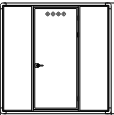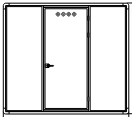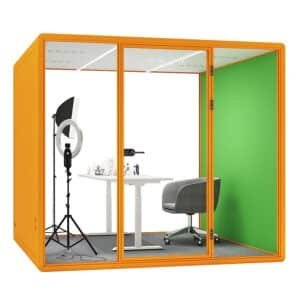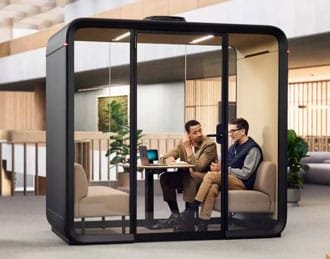
Blog
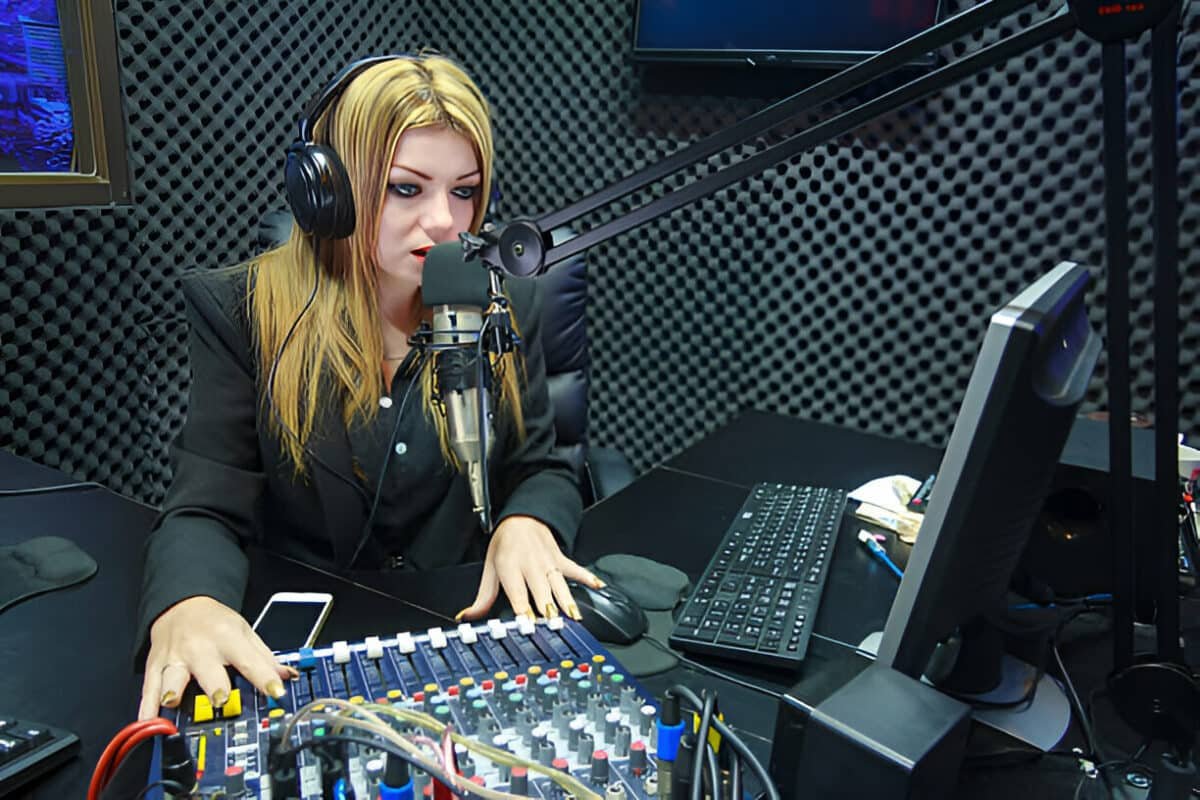
The Ultimate Guide to Soundproof Booths for Clear Podcast Audio
Ready to Eliminate Background Noise and Achieve Professional-Grade Audio for Your Podcast?
If you’ve ever listened back to a podcast episode and cringed at the hum of traffic, echoey voices, or the occasional dog bark in the background, you’re not alone. Even with top-tier mics and editing tools, background noise can seriously impact your podcast sound quality. That’s where a soundproof booth steps in as your ultimate audio ally.
A soundproof podcast booth isn’t just for high-end studios anymore. Whether you’re recording in a small apartment, a shared space, or a dedicated home studio, these booths help you create a controlled acoustic environment, blocking out distractions and letting your voice shine.
From amateur podcasters to professional content creators, investing in a sound isolation booth can be the game-changer that transforms your episodes from “just okay” to “studio quality.” It’s all about ensuring your message comes through loud, clear, and distraction-free—every single time.
In this guide, we’ll explore everything you need to know about soundproof booths for podcasting from how they work to what to consider before buying or building your own. Let’s get started on your journey to crystal-clear podcasting.
What is a Soundproof Booth and Why is it a Game-Changer for Podcasting?
A soundproof booth sometimes called an acoustic booth or vocal isolation booth is a compact, enclosed space designed specifically to block out external noise and minimize echo. Unlike casual home setups, these booths are purpose-built using specialized sound-absorbing materials that prevent sound from leaking in or out. The result? A quiet, focused space that helps you capture high-quality audio every time you hit “record.”
Whether you’re podcasting solo or hosting interviews, a soundproof booth becomes the core of a professional podcast studio, offering the kind of audio isolation that even advanced software can’t replicate.
The Critical Need for Soundproofing in Podcasting
In today’s competitive podcast landscape, audio quality is just as important as the content itself. Listeners are quick to tune out when they hear poor sound background chatter, echo, or inconsistent volume levels. Without soundproofing, even the best microphones can pick up ambient noise from appliances, street traffic, or other rooms in your house.
Soundproof booths help reduce background noise at the source, eliminating distractions before they even reach the mic. It’s the foundation for creating polished, professional-grade episodes your audience will appreciate.
Benefits of Using a Soundproof Booth
✅ Dramatically Reduces Background Noise
From honking cars to noisy neighbors, environmental sounds can disrupt a great podcast. A soundproof booth eliminates ambient noise, giving your audio that clean, studio-quality edge right from the start.
✅ Enhances Audio Clarity and Professionalism
When every word you speak is captured clearly, your podcast immediately sounds more professional. Audio clarity not only improves listener engagement, but it also reduces post-production time spent cleaning up poor-quality recordings.
✅ Creates a Dedicated and Controlled Recording Environment
With a booth, you’re no longer at the mercy of your surroundings. Whether it’s raining outside or your roommate is cooking in the next room, your recording environment stays consistent, session after session.
✅ Boosts Confidence and Focus for the Podcaster
There’s a psychological bonus, too—knowing you’re in a dedicated podcasting setup helps you get in the zone. No more worrying about sudden interruptions or inconsistent sound. You can focus entirely on your delivery, creativity, and connecting with your audience
The Problem: Background Noise – The Silent Podcast Killer
Understanding the Detrimental Impact of Noise on Podcast Quality
Let’s be honest—no matter how compelling your content is, if your listeners are constantly distracted by buzzing fridges, barking dogs, or street noise, they’re not going to stick around for long. Poor audio filled with background distractions leads to listener fatigue, decreased trust in your content, and a general feeling that your show isn’t professionally produced.
The unfortunate truth? Background noise can quietly sabotage your podcast. Even if your delivery is on point, noisy recordings can make you sound amateurish and cause listeners to tune out.
Common Sources of Noise in Home Recording Environments
You don’t need to live on a busy street or in a bustling household to deal with distracting sounds. Some of the most common noise culprits in a home podcast studio include:
- Passing traffic and outdoor construction
- Humming from air conditioners, refrigerators, or computers
- Family members, roommates, or pets in the background
- Echo and reverb caused by hard walls and empty rooms
These sounds might seem minor while you’re recording, but they show up clearly in your audio—and they can be tough to remove without affecting voice quality.
Why Standard Rooms Often Fail as Podcast Studios
At first glance, recording in your bedroom or spare office may seem like a budget-friendly choice. But standard rooms usually fall short due to poor acoustic treatment and lack of sound isolation. Most walls aren’t built to block outside noise, and flat surfaces create echo and reverb that muddy your voice.
This is where a soundproof podcast booth really earns its keep. It gives you the professional-level acoustic control that typical rooms just can’t provide—ensuring every episode sounds crisp, clean, and free from distractions.
The Solution: Soundproof Booths Your Personal Podcast Studio in a Box
How Soundproof Booths Work to Achieve Acoustic Isolation
A soundproof booth might seem like magic, but there’s real science behind its silence. These booths are engineered with multiple layers of dense, sound-absorbing materials that trap sound waves and reduce external noise before it ever hits your microphone.
Here’s how they pull it off:
- Layered construction: Thick walls made of acoustic foam, mass-loaded vinyl, and other specialized materials block and absorb sound.
- Sound absorption: Interior surfaces are lined with foam panels that minimize echo and reverb, ensuring a dry, clean vocal tone.
- Vibration damping: The booth structure is designed to reduce the transmission of low-frequency vibrations from the floor or surrounding environment.
All of this combines to create a space that’s acoustically isolated—perfect for capturing broadcast-quality podcast audio.
Transforming Any Space into a Professional Recording Environment
One of the best things about a portable sound booth is that it lets you turn almost any room into a professional recording environment. Whether you live in a small apartment or have a shared workspace, these booths give you the freedom to record whenever and wherever inspiration strikes, without compromising on quality.
Many models are modular, mobile, and compact, making them ideal for home podcasters who want great audio without building a dedicated studio from scratch.
Is a Soundproof Booth Right for You? Considerations for Podcasters Seeking Audio Excellence
A soundproof recording booth can be a game-changer—but is it the right fit for your podcasting goals?
Here are a few signs it might be time to upgrade:
- You consistently deal with background noise or echo in your recordings
- You’re looking to save time on post-production editing
- You want to take your audio from “good enough” to studio-grade
- You’re aiming to build a professional podcast brand or monetize your show
If any of these ring true, a home recording booth could be your best investment yet.
Exploring the Different Types of Soundproof Booths: Finding Your Perfect Fit
- Vocal Booths: Compact Champions of Voice Recording
- Characteristics of Vocal Booths: Small footprint, optimized for single-person voice recording.
- Pros of Vocal Booths: Space-saving, cost-effective, ideal for voice-centric podcasts.
- Cons of Vocal Booths: Limited space, may not accommodate multiple people or instruments.
- Best Use Cases: Solo podcast interviews, voice-overs, audiobook narration.
- Isolation Booths: Versatile Spaces for Comprehensive Sound Control
- Characteristics of Isolation Booths: Larger size, suitable for multiple participants or instruments.
- Pros of Isolation Booths: Versatility, greater acoustic isolation, potential for expanded use.
- Cons of Isolation Booths: Higher cost, larger space requirement, may be less portable.
- Best Use Cases: Co-hosted podcasts, musical performances, ensemble recordings.
- Portable Sound Booths: Recording Freedom, Wherever You Go
- Characteristics of Portable Sound Booths: Lightweight, collapsible designs for easy transport and setup.
- Pros of Portable Sound Booths: Maximum flexibility, ideal for mobile podcasting or location interviews.
- Cons of Portable Sound Booths: May offer slightly less sound isolation than fixed booths, can be less robust.
- Best Use Cases: On-location interviews, travel podcasting, flexible recording spaces.
DIY Sound Booth Options: Budget-Conscious Sound Reduction (with Caveats)
Exploring DIY Sound Booth Ideas
Not everyone is ready to invest in a professional-grade soundproof booth right away—and that’s okay. With a little creativity, you can still improve your podcast audio using DIY sound booth methods that help reduce some of that pesky background noise.
Here are a few popular approaches:
- Blanket forts: Drape heavy blankets over chairs or a frame to create a quick-and-dirty sound absorption booth.
- Closet conversions: A walk-in closet with clothes on all sides can double as a surprisingly effective recording space.
- Repurposed furniture: Old bookshelves or wardrobe cabinets can be transformed into home podcast setups with added foam or insulation.
These options are great for podcasters just starting out or looking to test the waters before committing to a professional solution.
Pros of DIY Booths
DIY setups offer some clear advantages:
- ✅ Low cost: Most materials are things you already have at home.
- ✅ Customizable: You can tailor your setup to your space and needs.
- ✅ Improved sound quality: Even basic absorption can reduce echo and reflections, giving your voice more clarity.
Cons of DIY Booths
That said, these makeshift booths come with limitations:
- ❌ Limited soundproofing: DIY setups reduce reverb but rarely block outside noise.
- ❌ Inconsistent results: Without proper materials, you may still hear echo or muffled audio.
- ❌ Time and effort: Building and tweaking a DIY booth can take significant trial and error.
If you’re looking for truly consistent, professional podcast sound isolation, DIY may only take you partway there.
When DIY Might Be an Option (and When to Consider a Professional Booth)
A DIY sound booth is a solid temporary fix or stepping stone—especially if you’re early in your podcast journey or working with a tight budget. But if you’re planning to scale, attract sponsors, or create a long-term content brand, investing in a professional soundproof booth can save you time, improve your sound, and elevate your entire podcast experience.
Ultimately, it’s about finding the right balance between budget, commitment, and the level of quality you want your audience to hear
- Choosing the Right Type of Soundproof Booth for Your Unique Podcasting Needs: Key considerations based on podcast format, space, and budget.
Key Features to Scrutinize When Selecting Your Soundproof Booth: Making Informed Decisions
- Noise Reduction Coefficient (NRC): Decoding Soundproofing Performance
- Understanding NRC Ratings: A measure of how much sound a material absorbs; higher NRC = better sound absorption.
- Why NRC Matters for Soundproof Booths: Quantifying the booth’s ability to block external noise and reduce internal reflections.
- Target NRC Ranges for Professional Podcasting: Recommendations for optimal noise reduction in different environments.
- Size and Dimensions: Ensuring a Comfortable and Functional Recording Space
- Matching Booth Size to Your Physical Space: Measuring your available area and booth footprint.
- Internal Dimensions and Ergonomics: Comfort for podcasters, equipment placement, and movement.
- Considering Future Needs: Anticipating potential growth in equipment or co-hosts.
- Portability vs. Permanence: Aligning with Your Recording Lifestyle
- Assessing Your Need for Portability: Frequent relocation, on-location recording, or fixed studio setup.
- Permanent Booths: Stability, potentially higher sound isolation, but fixed location.
- Portable Booths: Flexibility, ease of movement, but potentially less robust soundproofing.
- Hybrid Options: Booths designed for semi-permanent or adaptable setups.
- Materials and Construction: Pillars of Soundproofing and Longevity
- Key Materials Used in Soundproof Booths: Acoustic foam, dense fabrics, layered panels, vibration dampeners.
- Impact of Material Quality on Sound Isolation and Durability: Investing in quality for long-term performance.
- Construction Methods and Assembly: Ease of setup, structural integrity, and long-term stability.
- Ventilation and Airflow: Prioritizing Comfort and Clear Thinking During Recording Sessions
- The Importance of Ventilation in Enclosed Booths: Preventing stuffiness, maintaining air quality, and ensuring comfort.
- Ventilation Options in Soundproof Booths: Passive vents, active fan systems, and their effectiveness.
- Balancing Ventilation with Soundproofing: Ensuring airflow without compromising noise isolation.
- Expert Tip: Consider ventilation and comfort, especially for longer recording sessions, and prioritize comfortable seating and ergonomics inside the booth.
- Lighting: Illuminating Your Podcast Studio for Optimal Recording Conditions
- Integrated Lighting Options in Soundproof Booths: LED panels, adjustable lighting, and their features.
- Importance of Proper Lighting for Video Podcasts and Visual Comfort: Enhancing visual appeal and reducing eye strain.
- Light Temperature and Brightness Considerations: Creating a conducive and professional recording atmosphere.
- Ease of Assembly and Setup: Getting Your Booth Ready for Recording Quickly
- Assembly Complexity Across Different Booth Types: From simple pop-up booths to more intricate modular designs.
- Time Investment for Setup: Estimating the effort and time required to get the booth operational.
- Tools and Assistance Required: Assessing if professional assembly is needed or DIY-friendly.
- Budget and Pricing: Finding the Sweet Spot Between Features and Affordability
- Soundproof Booth Pricing Tiers: Entry-level, mid-range, and professional-grade booth costs.
- Balancing Features with Your Budget: Prioritizing essential features within your financial constraints.
- Long-Term Investment Value: Considering the return on investment in terms of improved audio quality and podcast growth.
Top Soundproof Booth Recommendations: Curated List of Market Leaders
- Recommendation 1: [High-End Professional Booth Example – e.g., Drums Booth Platinum Series] – The Ultimate Studio-Grade Sound Isolation
- Key Features: Exceptional NRC rating, premium materials, advanced ventilation, customizable options.
- Pros: Unmatched sound isolation, professional quality, durable construction, long-term investment.
- Cons: Highest price point, larger footprint, may require professional assembly.
- Best For: Professional podcasters, studios, musicians demanding the absolute best sound quality.
- Recommendation 2: [Mid-Range Popular Booth Example – e.g., WhisperRoom MDL 4848 S] – Versatile and Effective Sound Reduction for Serious Podcasters
- Key Features: Excellent NRC, modular design, good ventilation, variety of sizes available.
- Pros: Great balance of soundproofing and affordability, flexible sizing, reputable brand.
- Cons: Mid-range price point, assembly required, may be less portable than some options.
- Best For: Dedicated home podcasters, semi-professional setups, co-hosted podcasts.
- Recommendation 3: [Portable Booth Example – e.g., Piano box pro Portable Booth] – Sound Isolation On-the-Go Without Compromise
- Key Features: Highly portable, quick setup, surprisingly effective sound reduction for its class, durable travel case.
- Pros: Excellent portability, good soundproofing for a portable booth, easy to transport and store.
- Cons: Higher price for a portable booth, smaller internal space, may require careful handling during transport.
- Best For: Mobile podcasters, on-location interviews, podcasters with limited permanent space.
- Recommendation 4: [Budget-Friendly Booth Example – e.g., Audimute Sound Booth] – Affordable Entry into Sound Isolation for Home Recording
- Key Features: Cost-effective, decent sound reduction for the price, relatively easy assembly, space-saving designs.
- Pros: Most affordable option, good starting point for budget-conscious podcasters, improves home recording quality.
- Cons: Lower NRC compared to premium booths, may not be suitable for very noisy environments, potentially less durable.
- Best For: Beginner podcasters, home recording enthusiasts, those on a tight budget seeking sound improvement.
- (Continue with 2-3 more recommendations at different price points and types, ensuring variety)
- Expert Tip: Optimize booth placement by positioning your soundproof booth away from corners and walls for best acoustic performance, minimizing potential standing waves.
Comparative Analysis Table: Side-by-Side Booth Feature Breakdown
Comparative Analysis Table: Side-by-Side Booth Feature Breakdown
Soundproof Booth Comparison – Key Features for Informed Decision-Making
| Feature | VocalBoothToGo SPB Series | Meavo Office Phone Booth | Mute Labs Phone Booth | SilentBoxPro Drums Booth | SilentBoxPro Soundproof Box |
| Noise Reduction (NRC) | STC 30 (±5 dB) | ISO 23351 Class A | Not specified | STC 30 (±5 dB) | STC 30 (±5 dB) |
| Internal Dimensions | Varies by model | Not specified | Not specified | W95.47″ x D93.74″ x H85.43″ | W56.89″ x D47.56″ x H85.43″ (Model M) |
| External Dimensions | Varies by model | Not specified | Not specified | W100.59″ x D97.24″ x H90.55″ | W62.01″ x D50.98″ x H90.55″ (Model M) |
| Portability | Yes | Partial | Partial | Partial | Partial |
| Ventilation | Built-in ventilation system | Integrated ventilation system | Integrated ventilation system | Exhaust fan included | Exhaust fan included |
| Lighting | LED lighting included | LED lighting included | LED lighting included | LED 3000K lighting | LED 3000K lighting |
| Assembly Complexity | Moderate | Moderate | Moderate | High | High |
| Price Range | Varies by model | Not specified | Not specified | $8,649.04 – $9,610.58 | $4,802.88 – $9,610.58 |
| Best Use Case | Home studios, vocal recording | Office calls, meetings | Office calls, meetings | Drum practice, music recording | Business meetings, focused work |
- Why a Comparison Table Empowers Your Choice: Quickly assess key differences and identify the best booth based on your priorities.
Buying Guide: Step-by-Step to Choosing Your Ideal Soundproof Booth
- Step-by-Step Guide to Selecting Your Perfect Soundproof Booth for Podcasting Success
- Step 1: Define Your Podcasting Needs and Recording Environment:
- Assess your podcast format (solo, co-hosted, interviews, music).
- Evaluate your current recording space and identify noise challenges.
- Determine your desired level of sound isolation and audio quality.
- Step 2: Establish Your Budget and Investment Range:
- Determine how much you are willing to invest in a soundproof booth.
- Consider financing options if needed for higher-end models.
- Factor in potential long-term cost savings from improved audio quality.
- Step 3: Determine the Ideal Booth Type and Size for Your Setup:
- Choose between vocal booths, isolation booths, or portable options based on your needs (refer to “Types of Soundproof Booths” section).
- Select the appropriate booth size to comfortably accommodate your equipment and podcasters.
- Measure your available space to ensure the booth fits properly.
- Step 4: Prioritize Key Features Based on Your Specific Requirements:
- Focus on NRC rating, size, portability, ventilation, and other crucial features (refer to “Key Features to Consider” section).
- Rank features in order of importance to guide your selection process.
- Consider features that align with your long-term podcasting goals.
- Step 5: Explore User Reviews, Testimonials, and Case Studies:
- Read online reviews and forums to gather user experiences with different booth models.
- Look for user-submitted audio samples recorded in various booths (if available).
- Seek out case studies or testimonials from podcasters using soundproof booths.
- Step 6: Compare Top Models and Check Availability & Pricing:
- Utilize the comparative analysis table to compare the shortlisted booth models.
- Check current pricing and availability from reputable retailers or manufacturers.
- Compare warranty and return policies before making a final decision.
- Step 7: Consider Long-Term Value, Scalability, and Future-Proofing:
- Think beyond immediate needs and consider long-term podcasting aspirations.
- Choose a booth that can accommodate potential equipment upgrades or changes in podcast format.
- Invest in quality and durability for lasting performance and value.
- Essential Questions to Ask Before You Invest in a Soundproof Booth:
- What is the actual NRC rating verified by independent testing?
- What are the ventilation and airflow specifications?
- What is the warranty period and manufacturer support offered?
- Are there user reviews or audio samples available?
- What is the return policy if the booth doesn’t meet expectations?
- Expert Tip: Manage internal acoustics even within a booth, consider adding acoustic panels or bass traps inside to further refine the sound and reduce any remaining reflections.
- Common Questions and Expert Answers to Enhance Your Understanding
- How Do I Properly Set Up a Soundproof Booth?
- Step-by-step guide to assembly (if required) and placement.
- Cable management tips for a clean and organized booth interior.
- Initial acoustic testing after setup to ensure optimal performance.
- What is the Best Way to Maintain My Soundproof Booth?
- Cleaning and care recommendations for booth materials.
- Ventilation system maintenance for optimal airflow.
- Periodic checks for any wear and tear or acoustic leaks.
- Can I Further Improve the Acoustics Inside My Soundproof Booth?
- Importance of internal acoustic treatment even within a booth.
- Recommendations for adding acoustic panels, bass traps, or diffusers inside.
- Expert Tip: Manage internal acoustics: Even within a booth, consider adding acoustic panels or bass traps inside to further refine the sound and reduce any remaining reflections.
- Soundproof Booth vs. DIY Soundproofing: Which Approach is Better for Podcasting?
- Comparative analysis of cost, effectiveness, and time investment for both methods.
- When DIY might be sufficient and when a professional booth becomes essential.
- Real-world limitations of DIY soundproofing for critical audio recording.
- Are Soundproof Booths Truly 100% Soundproof?
- Clarifying the concept of sound isolation vs. absolute soundproofing.
- Understanding realistic expectations for noise reduction in soundproof booths.
- Factors that can influence the overall sound isolation performance.
- What About Ventilation and Comfort During Long Recording Sessions in a Booth?
- Reiterating the importance of ventilation and airflow for comfort and focus.
- Addressing potential concerns about claustrophobia or discomfort in enclosed spaces.
- Expert Tip: Cable management is key: Plan your cable routing to keep the booth interior tidy and prevent cable noise from being picked up by the microphone.
Conclusion: Embrace Silent Recording and Elevate Your Podcast to New Heights
Key Takeaways: Soundproof Booths – Your Investment in Podcast Excellence
In the fast-paced world of podcasting, audio quality can make or break your show. A soundproof booth isn’t just a fancy upgrade—it’s an essential tool for anyone serious about producing clean, professional audio. From eliminating background noise to creating a distraction-free environment, these booths transform any space into a professional podcast studio.
Let’s recap the core benefits:
- ✅ Crystal-clear sound that keeps listeners engaged
- ✅ Consistent recording environment, no matter your location
- ✅ Reduced editing time and post-production headaches
- ✅ A confident, focused mindset every time you record
Whether you’re launching your first episode or looking to level up your current podcast setup, a soundproof recording booth is a smart, long-term investment.
Your Next Steps: From Research to Recording in Pristine Silence
If you’re ready to take your podcast to the next level, here’s how to get started:
- Explore Top-Rated Soundproof Booths
Dig into expert reviews, specs, and comparisons to find booths tailored to your style and space. - Check Prices and Availability
Compare models based on features, dimensions, and budget. Look for trusted retailers or direct-from-manufacturer options. - Read User Reviews and Case Studies
Learn from other podcasters who’ve already made the leap. Their insights can help you avoid common pitfalls and choose confidently.
Recent Posts


DIY Soundproof Booth: A Complete Guide to Building and Installing Your Own

Ultimate Soundproof Drum Box Pro Guide: Build Your Silent Practice Space

Top Soundproof Office Pods: 2025 Buyer’s Guide & Comparison for Enhanced Productivity and Privacy



